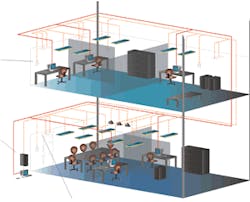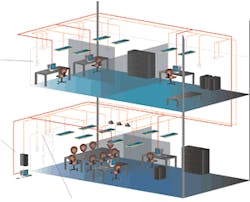DALI: The Next Breakthrough in Lighting?
The Digital Addressable Lighting Interface (DALI) protocol has opened new opportunities in lighting flexibility and energy savings.DALI is not a product or system. Instead, it’s a standard that defines how ballasts have to perform—in this case, specifically, digital ballasts. The ballasts are dimmable and, thanks to DALI, individually addressable and interoperable with controls that are compatible with the same protocol.The value proposition of digital ballasts is that they can be networked to a central point of control, such as a computer, as well as local points of control, such as a wall-mounted dimmer, for scheduled and manual dimming and switching. Dimming—once the province of architectural lighting, daylight harvesting and conference rooms—can therefore be deployed across an entire facility to achieve high energy savings (30-60 percent including ballast-lamp efficiency, according to digital ballast maker Tridonic) as well as an unprecedented degree of flexibility and user control. “Digital addressable ballast capabilities are enhancing the flexibility and possibilities of dimming installations,” says Guido Walther, CEO of Tridonic. “DALI provides confidence that products from multiple manufacturers will be compatible and interoperable.” While it all sounds sophisticated, most of the hardware in a digital lighting network is familiar—ballasts, lamps, controls, wiring. The ballasts are digital 120/277V fluorescent electronic ballasts, available in one- and two-lamp models for operation of linear T5, T5HO and T8 fluorescent lamps as well as compact fluorescent lamps. According to Tridonic, digital ballast and DALI interfaces with soon be available for HID, incandescent and low-voltage halogen systems. Digital ballasts “soft start” the lamps to maximize service life, cut the lamps out at end of life, gradually dim, and start the lamps at any point in their very wide dimming range (from 100 to one percent).The ballasts are connected to form a lighting bus, or loop, of up to 64 ballasts. Each ballast is given an address in the system so that it can be individually controlled or lumped together in a controlled group. Each group is then connected to a DALI-compatible control device, which may be a local wall-mounted control that enables manual push-button switching to select programmed dimming scenes; a computer for centralized lighting control; local PCs for individual occupant control; and occupancy sensors, photosensors and other controls. Once the network is established, we gain the capability of telling each ballast what to do and when, while the ballast can talk back, giving us information about its operation.Create a lighting bus (DALI) by simply connecting 2
wires between all ballasts and controls
WireWall switch with raise, lower, ON, OFF capability or a multi buffon scene
controller
Adapter-Translates RS232 to DALI lighting bus, For larger installations using multiple DALI lighting buses other standard IT components may be used.
Local wall controls can be added by connecting to the nearest lighting network
wires between all ballasts and controls
WireWall switch with raise, lower, ON, OFF capability or a multi buffon scene
controller
Adapter-Translates RS232 to DALI lighting bus, For larger installations using multiple DALI lighting buses other standard IT components may be used.
Local wall controls can be added by connecting to the nearest lighting network
Daylight and occupancy sensors can be directly connected to lighting bus Benefits of digital lighting networks include:Energy savings. Digital ballasts can be dimmed or switched either on a scheduled basis according to time of day (such as during peak demand periods) or in response to variable conditions such as quantity of available daylight. “As energy costs continue to rise, intelligent use of available daylight and increased monitoring of lighting system usage will be key to avoid wasting energy,” says Paul Ratliff, product marketing manager at OSRAM SYLVANIA’s Electronic Control Systems division. “DALI protocol provides the basis for smarter, more cost-effective lighting systems.”Worker satisfaction. A study completed by the Light Right Consortium found that occupants are more satisfied and motivated when they are able to set light levels to their own preferences; a recent Watt Stopper-funded study found that a significant portion of the market would pay a premium for this capability.Flexibility. The lights can be dimmed to tune light levels to changing space needs, without the need for rewiring, a significant advantage over 0-10V analog dimming systems.“DALI will provide greater flexibility and eliminate the need for rewiring if building layouts change,” says Stuart Berjansky, dimming product manager for Advance Transformer Co.Maintenance. The central computer can collect information from the ballasts as well as transmit it, turning the central point of control into a monitoring station that recognizes anomalies (such as lamp failures) and signals a maintenance need via alarms.Demand for digital lighting networks is currently inhibited by several factors, including:Compatibility. To set up a working digital lighting network, all lighting controls connected to the network must be DALI-compatible.“Development and introduction of DALI ballasts and controls have been slow in Europe and North America,” says Berjansky of Advance. “The key issue is the limited availability of DALI-compatible controls, which are a critical component of the system.” Complexity. Digital lighting networks are more sophisticated than traditional lighting systems in regards to set-up, programming and commissioning. As a result, like building automation systems, they are generally best suited for large installations.“The development of digital lighting networks has been slow in coming due to the complexity of the system, which requires matched components together with initial commissioning issues,” says A.J. Glaser, president of HUNT Dimming. “Once it is fully realized, building owners will enjoy greatly enhanced control over their environment, both today and in the future due to the built-in flexibility of the system.”

